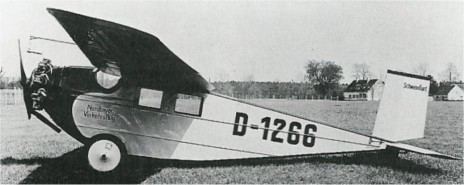Wingspan 16 m | Length 8 m | |
 | ||
The Messerschmitt M 18 (later also known as the BFW M 18) was an airliner produced in Germany in the late 1920s.
Contents
Design and development
Designed at the request of Theodor Croneiss to supply his new airline venture which was to become Nordbayerische Verkehrsflug (NOBA), it was a conventional high-wing cantilever monoplane with fixed tailskid undercarriage. The prototype was built of wood, although production examples would have a metal structure. The design was praised in its day for the cleanness of its aerodynamics, lightness of construction, and economy of operation
Operational history
The first M 18 to enter service with NOBA was provided by Messerschmitt in exchange for a 49% share of the new company, and on 26 July it began commercial flights. NOBA's early successes enabled the company to place orders for additional examples of an improved model, the M 18b. It would eventually purchase twelve of these, but manufacturing them would exceed the capacity of Messerschmitt's own small firm, leading to a merger with Bayerische Flugzeugwerke (BFW) in 1927. Following NOBA's reorganisation into DEVAG in 1931, a small number of a further improved version designated M 18d were ordered, but the type was soon superseded by the similar but larger Messerschmitt M 20.
Variants
Operators
Specifications (M 18b)
Data from The Illustrated Encyclopedia of Aircraft, 494. Weights from,
General characteristics
Performance
